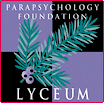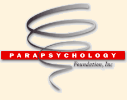 |
 |
| THE BIOGRAPHICAL DICTIONARY OF PARAPSYCHOLOGY EUSAPIA PALLADINO Medium. B. January 21, 1854, Minerverno Murgo, Bari, Italy; d. May 16, 1918. M. Raphael Delgaiz. Considered by many to be Europe's outstanding physical medium, Eusapia Palladino, like most physical mediums, was for the greater part of her career the center of heated dispute. Probably no medium has been investigated by a greater number of scientific committees and learned individuals, but each investigation seemed only to increase the ranks of both her convinced supporters and her skeptical critics. Eusapia was born in a tiny Italian village, the child of peasants. Orphaned at twelve, she went to Naples to work as a laundress. There she was sheltered by a familiar who dabbled in spiritualism. Her participation in their seances produced phenomena which aroused interest among local students of the occult. One of these was Ercole Chiaja, who took Eusapia, as a professional medium, to Paris, where he read a paper on her psychic abilities. Eusapia then demonstrated her mediumship by levitation, causiing herself to rise without apparent physical agency in full light before the meeting. The famous Italian psychiatrist and criminiologist Cesare Lombroso, formerly skeptical of Eusapia's mediumship, was now converted to belief in its authenticity. He arranged for her to undergo a series of tests before a scientific commission in Milan, followed by another series of tests in Naples in 1893. The conditions for these tests were dictated by Eusapia herself. They resulted in wide acceptance of her mediumship throughout Italy. In the next few years Eusapia held sittings in Poland, France and England. Although sittings would begin with a maximum of light, "John King," Eusapia's "spirit control," would demand less light, Eusapia would protest but eventually give way, and manifestations would begin in diminishing light and continue in darkness. These phenomena would include mysterious raps, the appearance of lights, the twanging of a guitar, levitation of the seance table, and the movement of objects about the seance room without evident physical cause. Eusapia's forty sittings in Warsaw resulted in charges of fraud; but opinion was divided. The physiologist and psychic researcher Charles Richet (q.v.) invited her to undergo tests at his home in the south of France with such observers present as Sir Oliver Lodge, the Sidgwicks and Albert von Schrenck-Notzing (qq.v.), all of whom were favorably impressed. A series of sittings at Cambridge at the invitation of F. W. H. Myers (q.v.) followed. Richard Hodgson (q.v.), who on the basis of reports of earlier Palladino sittings had concluded that she used trickery, attended the Cambridge sittings and saw no reason to change his mind. He charged that Eusapia used a freed hand or leg to produce the seance manifestations and demonstrated how she cold have done this. Professor Richet, however, declared that the Cambridge researchers provoked the fraud they had detected, and Eusapia returned to France for further sittings, consenting to more stringent controls on her hands and legs. Her production of physical phenomena under these conditions now convinced Myers. Many Italian sittings followed. In 1908 the Society of Psychical Research appointed Hereward Carrington, Everard Feilding (qq.v.) and W. W. Baggally to investigate Eusapia at seances in Italy. All three men were experienced investigations and familiar with all the known tricks. They found her phenomena for the most part genuine and reported in the SPR Proceedings in 1909 that the manifestations were produced by "some force...beyond the reach of ordinary control and beyond the skill of the most skillful conjuror." It is possible that much of the difficulty in assessing the Palladino sittings stemmed from the mercurial personality of the medium, often in conflict with that of the staid academic researchers. Acording to Eric Dingwall (q.v.) "Eusapia was vital, vulgar, amorous and a cheat." Carrington, although he acknowledged that she cheated on occasion, believed she used trickery only when her psychic energies were weak, both because she did not want to disappoint her sitters and because she took a "mischievous delight in seeing how far she could go in hoodwinking" them. Carrington bought Eusapia to the United States late in 1909, and in January, 1910, six sittings were held at Columbia University before an academic group, with experts in magic and fraud also attending. Eusapia was permitted to demonstrate her abilities under lax conditions, but when more rigid conrols were imposed, phenomena ceased. Further doubt was thus cast on her mediumship and Eusapia, her health failing, returned to Europe where she retired into a deep seclusion that lasted until her death. See "An Estimate of Palladino" (Cosmopolitan magazine, Feb. 1910) by Wlliam James; Very Peculiar People (1950) by Eric J. Dingwall; The American Seances with Eusapia Palladino (1954) by Hereward Carrington. Taken from Helene Pleasants (1964) Biographical Dictionary of Parapsychology with Directory and Glossary 1946-1996 NY: Garrett Publications |
 |

|
 www. parapsychology. org |
||